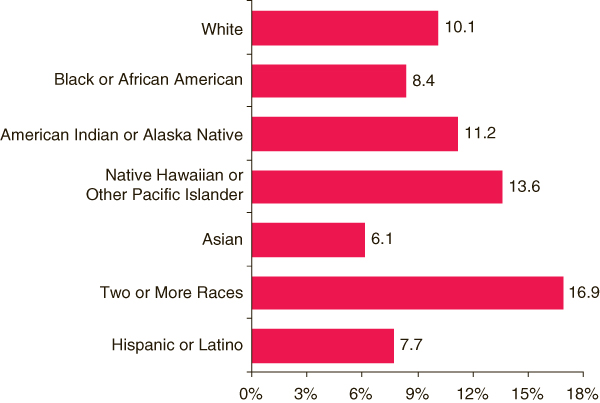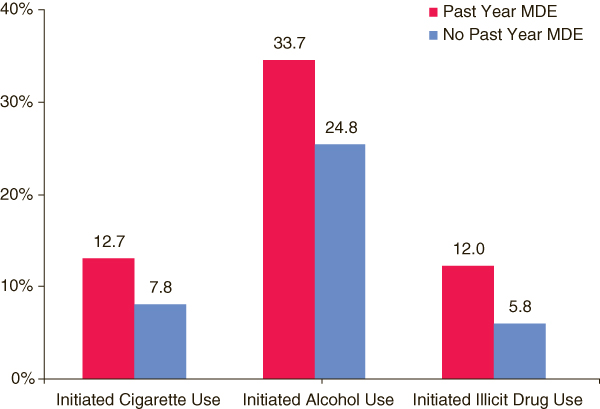 |
| November 15, 2007 |
Depression and the Initiation of Cigarette, Alcohol, and Other Drug Use among Young Adults
In Brief
- Combined data for 2005 and 2006 indicate that 9.4 percent of young adults aged 18 to 25 (3.0 million persons) experienced at least one major depressive episode (MDE) in the past year
- Among young adults aged 18 to 25 who had not previously used alcohol, those who experienced a past year MDE were more likely to have initiated alcohol use in the past year than those who had not experienced a past year MDE (33.7 vs. 24.8 percent)
- Among young adults aged 18 to 25 who had not previously used any illicit drug, those who experienced a past year MDE were twice as likely to have initiated use of any illicit drug in the past year as those who had not experienced a past year MDE (12.0 vs. 5.8 percent)
|
Research has shown a strong association between mental disorders and substance use disorders.1 There is evidence that this linkage may be bidirectional: depression may be associated with an escalation of substance use, and chronic substance abuse may be a factor in the development of depression.2 The association between depression and the initiation of alcohol and other drug use among youths aged 12 to 17 was investigated in a previous issue of The NSDUH Report.3 This report examines the linkage among young adults aged 18 to 25.
The National Survey on Drug Use and Health (NSDUH) includes questions for adults aged 18 or older to assess lifetime and past year major depressive episode (MDE). For these estimates, MDE is defined using the diagnostic criteria set forth in the 4th edition of the Diagnostic and Statistical Manual of Mental Disorders (DSM-IV),4 which specifies a period of 2 weeks or longer during which there is either depressed mood or loss of interest or pleasure and at least four other symptoms that reflect a change in functioning, such as problems with sleep, eating, energy, concentration, and self-image.5
NSDUH also asks adults aged 18 or older to report on their use of cigarettes, alcohol, and illicit drugs in their lifetime and in the past year. Illicit drugs refer to marijuana/hashish, cocaine (including crack), inhalants, hallucinogens, heroin, or prescription-type drugs used nonmedically.6 Respondents who reported use of a given substance were asked how old they were when they first used it;7 responses to these questions were used to identify persons at risk for substance use initiation (i.e., persons who had never used the substance in their lifetime or used the substance for the first time within the 12 months preceding the survey) and to identify past year initiates (i.e., persons who used the substance for the first time in the 12 months prior to the survey).
This issue of The NSDUH Report examines past year MDE; past year initiation of cigarette, alcohol, and illicit drug use; and the association between MDE and the initiation of cigarette, alcohol, or other drug use in the past year among young adults aged 18 to 25. All findings presented in this report are based on combined 2005 and 2006 NSDUH data.
Past Year MDE
Combined data for 2005 and 2006 indicate that 9.4 percent of young adults aged 18 to 25 (3.0 million persons) experienced at least one MDE in the past year. Female young adults were nearly twice as likely as their male counterparts to have experienced a past year MDE (12.3 vs. 6.5 percent). Rates of past year MDE varied by racial/ethnic group, with the lowest rate among Asian young adults (6.1 percent) and the highest rate among those reporting two or more races (16.9 percent) (Figure 1).
Figure 1. Prevalence of Past Year Major Depressive Episode (MDE) among Young Adults Aged 18 to 25, by Racial/Ethnic Group*: 2005 and 2006
 |
Figure 1 Table. Prevalence of Past Year Major Depressive Episode (MDE) among Young Adults Aged 18 to 25, by Racial/Ethnic Group*: 2005 and 2006
| Racial/Ethnic Group |
Percent |
| White |
10.1% |
| Black or African American |
8.4% |
| American Indian or Alaska Native |
11.2% |
| Native Hawaiian or Other Pacific Islander |
13.6% |
| Asian |
6.1% |
| Two or More Races |
16.9% |
| Hispanic or Latino |
7.7% |
| Source: SAMHSA, 2005 and 2006 NSDUHs. |
Initiation of Cigarette, Alcohol, and Illicit Drug Use in the Past Year
Combined data for 2005 and 2006 indicate that an estimated 943,000 adults aged 18 to 25 were past year initiates of cigarette use, which represents 8.0 percent of young adults who were at risk for initiating cigarette use. During that same period, 1.5 million young adults were past year initiates of alcohol use, representing 25.1 percent of young adults who were at risk for initiation of alcohol use. An estimated 870,000 young adults were past year initiates of illicit drug use, which represents 6.1 percent of young adults at risk for initiation of illicit drug use.
MDE and Substance Use Initiation in the Past Year
Among young adults aged 18 to 25 who had not previously used cigarettes, those who experienced a past year MDE were more likely to have initiated cigarette use in the past year than those who had not experienced a past year MDE (12.7 vs. 7.8 percent) (Figure 2). Among young adults who had not previously used alcohol, those who experienced a past year MDE were more likely to have initiated alcohol use in the past year than those who had not experienced a past year MDE (33.7 vs. 24.8 percent). Similarly, among young adults aged 18 to 25 who had not previously used any illicit drug, those who experienced a past year MDE were twice as likely to have initiated use of any illicit drug in the past year as those who had not experienced a past year MDE (12.0 vs. 5.8 percent). This pattern was relatively consistent across specific drug types (Table 1).
Figure 2. Percentage of Young Adults Aged 18 to 25 Initiating Substance Use in the Past Year among Those Who Had Not Previously Used, by Past Year Major Depressive Episode (MDE): 2005 and 2006
 |
Figure 2 Table. Percentage of Young Adults Aged 18 to 25 Initiating Substance Use in the Past Year among Those Who Had Not Previously Used, by Past Year Major Depressive Episode (MDE): 2005 and 2006
| Substance Use |
Past Year MDE
Percent |
No Past Year MDE
Percent |
| Initiated Cigarette Use |
12.7% |
7.8% |
| Initiated Alcohol Use |
33.7% |
24.8% |
| Initiated Illicit Drug Use |
12.0% |
5.8% |
| Source: SAMHSA, 2005 and 2006 NSDUHs. |
Table 1. Percentage of Young Adults Aged 18 to 25 Initiating Illicit Drug Use in Past Year among Those Who Had Not Previously Used, by Past Year Major Depressive Episode (MDE): 2005 and 2006
| Drug Group |
Past Year MDE
Percent |
No Past Year MDE
Percent |
| Marijuana |
9.1% |
4.2% |
| Cocaine (Including Crack) |
3.5% |
1.8% |
| Heroin |
0.3% |
0.2% |
| Hallucinogens |
3.1% |
1.8% |
| Inhalants |
1.6% |
0.7% |
| Nonmedical Use of Pain Relievers** |
7.1% |
2.8% |
| Nonmedical Use of Tranquilizers** |
4.0% |
1.4% |
| Nonmedical Use of Stimulants** |
2.3% |
0.9% |
| Nonmedical Use of Sedatives** |
0.5% |
0.2% |
| Source: SAMHSA, 2005 and 2006 NSDUHs. |
End Notes
1 Jane-Llopis, E., & Matytsina, I. (2006). Mental health and alcohol, drugs and tobacco: A review of the comorbidity between mental disorders and the use of alcohol, tobacco and illicit drugs. Drug and Alcohol Review, 25, 515-536.
2 Sinha, R., & Rounsaville, B. J. (2002). Sex differences in depressed substance abusers. Journal of Clinical Psychiatry, 63, 616-627.
3 Substance Abuse and Mental Health Services Administration, Office of Applied Studies. (May 3, 2007). The NSDUH Report: Depression and the Initiation of Alcohol and Other Drug Use among Youths Aged 12 to 17. Rockville, MD.
4 American Psychiatric Association. (1994). Diagnostic and statistical manual of mental disorders (4th ed.). Washington, DC: Author.
5 In assessing MDE, no exclusions were made for MDE caused by medical illness, bereavement, or substance use disorders.
6 NSDUH measures the nonmedical use of prescription-type pain relievers, sedatives, stimulants, or tranquilizers. Nonmedical use is defined as the use of prescription-type drugs not prescribed for the respondent by a physician or used only for the experience or feeling they caused. Nonmedical use of any prescription-type pain reliever, sedative, stimulant, or tranquilizer does not include over-the-counter drugs. Nonmedical use of stimulants includes methamphetamine use.
7 Respondents whose age at first use was equal to or 1 year less than their current age were asked to indicate the month in which they initiated their use of that drug.
Figure and Table Notes
* Race/ethnicity categories are determined by combining the responses from two separate questions. For this report, respondents identifying themselves as Hispanic were assigned to the Hispanic group regardless of their racial identification. Respondents identifying themselves as non-Hispanic were grouped according to their racial identification. Thus, “white” refers to those identifying themselves as non-Hispanic and white.
** See End Note 6.
Suggested Citation
Substance Abuse and Mental Health Services Administration, Office of Applied Studies. (November 15, 2007). The NSDUH Report: Depression and the Initiation of Cigarette, Alcohol, and Other Drug Use among Young Adults. Rockville, MD.
The National Survey on Drug Use and Health (NSDUH) is an annual survey sponsored by the Substance Abuse and Mental Health Services Administration (SAMHSA). The 2005 and 2006 data used in this report are based on information obtained from 44,459 young adults aged 18 to 25. The survey collects data by administering questionnaires to a representative sample of the population through face-to-face interviews at their place of residence.
The NSDUH Report is prepared by the Office of Applied Studies (OAS), SAMHSA, and by RTI International in Research Triangle Park, North Carolina. (RTI International is a trade name of Research Triangle Institute.)
Information on NSDUH used in compiling data for this report is available in the following publications:
Office of Applied Studies. (2007). Results from the 2006 National Survey on Drug Use and Health: National findings (DHHS Publication No. SMA 07-4293, NSDUH Series H-32). Rockville, MD: Substance Abuse and Mental Health Services Administration.
Office of Applied Studies. (2006). Results from the 2005 National Survey on Drug Use and Health: National findings (DHHS Publication No. SMA 06-4194, NSDUH Series H-30). Rockville, MD: Substance Abuse and Mental Health Services Administration.
Also available online: http://www.oas.samhsa.gov.
Because of improvements and modifications to the 2002 NSDUH, estimates from the 2002, 2003, 2004, 2005, and 2006 surveys should not be compared with estimates from the 2001 or earlier versions of the survey to examine changes over time. |
| The NSDUH Report is published periodically by the Office of Applied Studies, Substance Abuse and Mental Health Services Administration (SAMHSA).All material appearing in this report is in the public domain and may be reproduced or copied without permission from SAMHSA. Additional copies of this report or other reports from the Office of Applied Studies are available online: http://www.oas.samhsa.gov. Citation of the source is appreciated. For questions about this report, please e-mail: shortreports@samhsa.hhs.gov. |
|
This page was last updated on December 30, 2008.
|



